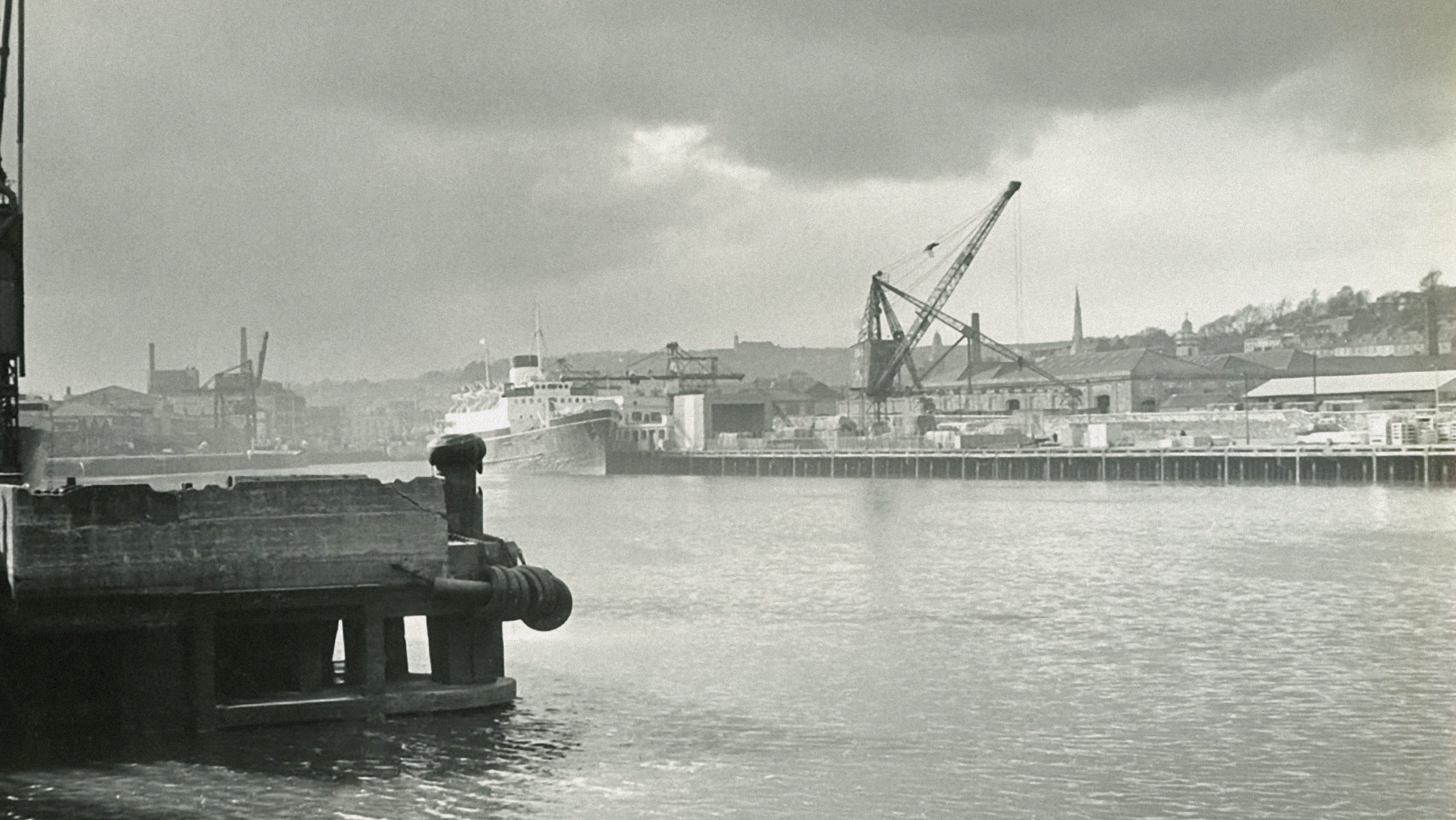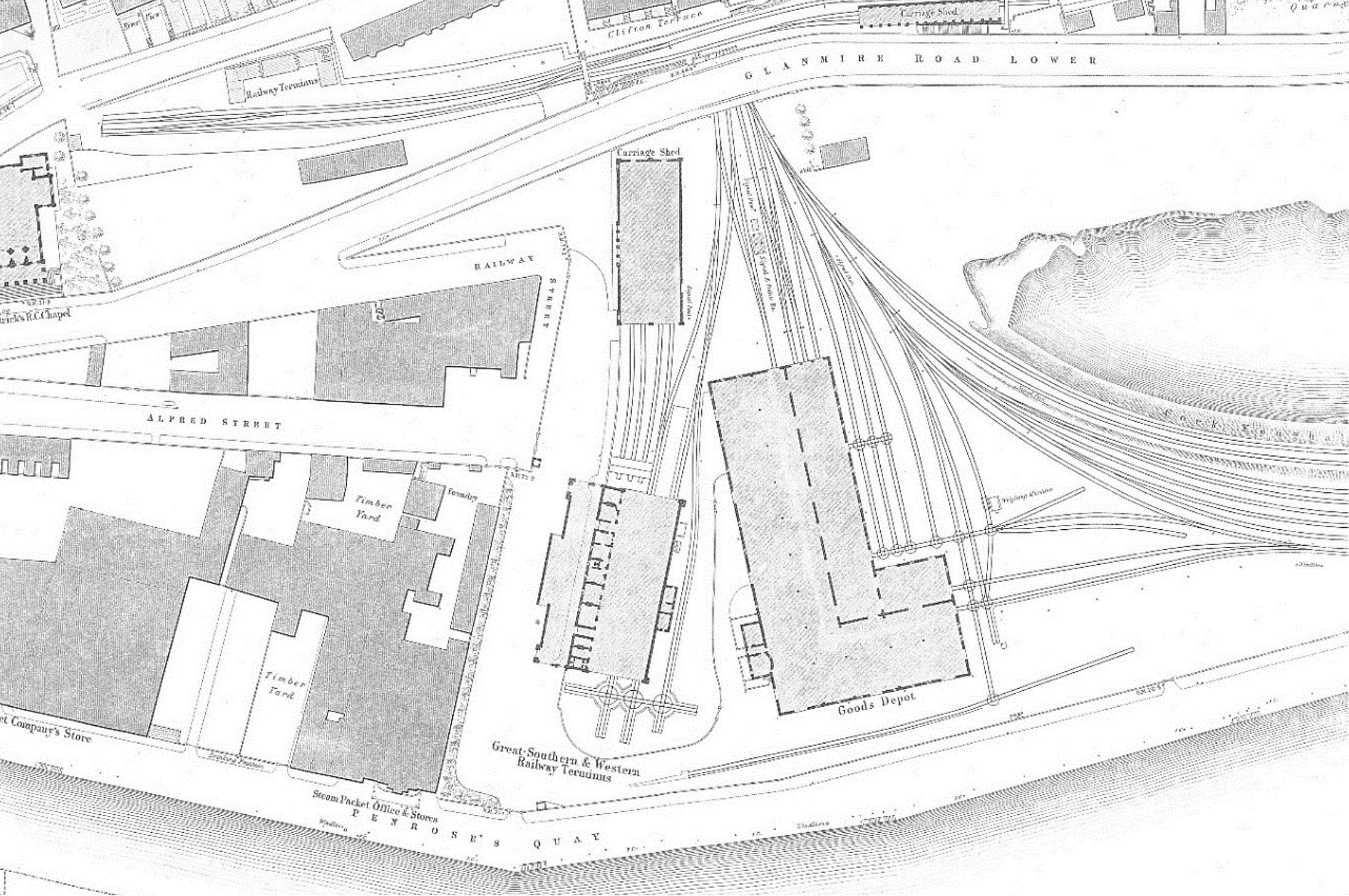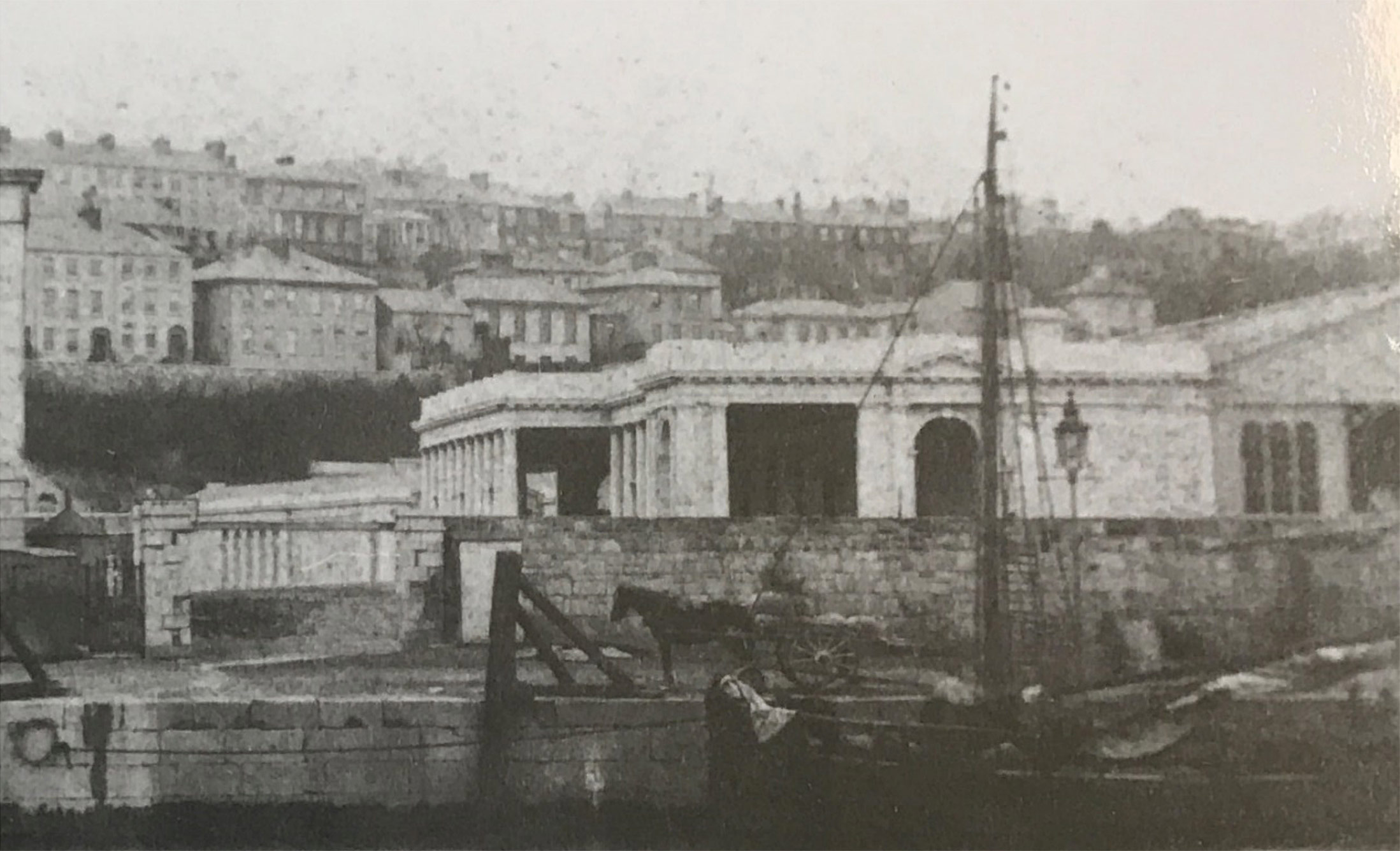
BUILDING ON
TRADITION
Spanning 6 acres and located on the River Lee next to the Port of Cork, the Horgan’s Quay development comprises a new scheme of contemporary offices, homes, hotel, leisure facilities, shops and restaurants. The restoration of the on-site heritage buildings such as the goods shed, carriage shed and original station house make the centre pieces of this mixed use development.
HISTORY OF
HORGAN’S QUAY SITE
The original Cork terminus on the Great Southern and Western Railway company’s Dublin to Cork line was at Kilbarry (Blackpool), with the first train between the two cities in 1849, some 15 years after the first railway line had been constructed in Dublin in 1834. Following the completion of the very extensive Glanmire Tunnel in 1854, a new station was designed to be built at Penrose Quay, just beyond the city entrance to the tunnel, and the new line was opened on 3 December 1855. For the first few months, passenger trains ran into the Goods Shed at the new station site, until the new Penrose Quay Station was opened on July 28th, 1856. Penrose Quay station was Cork’s principal station for almost 40 years. Its main entrance was on Penrose Quay, with a side entrance for passengers at the end of Alfred Street. Alfred Street led directly east from King Street (now MacCurtain Street), which had developed as a key route east from the city after the building of St. Patrick’s Bridge in 1789.

Figure 1: OS map, 1869, showing the newly developed Great Southern and Western Railway Terminus, Carriage Shed and Goods Shed.

Figure 2: Early photograph c. 1857 of the original Penrose Quay Railway Terminus (Irish Architectural Archive).
The Stationmaster’s building is all that remains now of the original Penrose Quay Terminus, but it had been a very substantial and impressive building when first fully completed in 1860, designed by the prominent Cork architect and engineer, Sir John Benson, and built of local white limestone. To the west side of the new station building was an elegant colonnade of twenty Doric columns, forming a covered way of 200 feet long in the centre, to which passengers could be brought by carriage in order to enter the station building. The building standing today formed the offices at the centre of the building (including waiting rooms and booking offices), while to the east of the present building were the covered railway platforms.
This station building was closed to passenger traffic in 1893, when the present Lower Glanmire Road station was built. The Penrose Quay station was converted into a cattle loading depot, as it was convenient to the quays, with the original passenger arrival platform widened and fitted with cattle pens.
The western elevation was apparently demolished in around 1895/6, with the limestone columns and decorative elements possibly sold for re-use elsewhere. The central railway offices, which had originally housed waiting rooms, booking offices and other functions were retained as offices for Civil Engineers.
To the east of the Railway Terminus, the Goods Shed had been completed just before the passenger station opened. The Southern Reporter article, published on 22 May 1855, just after the building was completed, describe the building as having ‘been constructed on the most substantial and permanent plan; the quoins, plinths, cornices and windows are of neatly chiselled limestone; the walls are of limestone, hammer dressed and the whole presents a handsome frontage to the road and river, and, when completed, will materially improve that portion of the city. It was designed by Mr John Bagnell’. The building contained a series of railway platforms, onto which goods could be directly loaded, and an office building to its west side.
The carriage shed, which was used to repair and work on rolling stock, was the third to be completed of the three surviving historic railway buildings within the present development site. It was designed by the prolific Cork architect, Joshua Hargrave, who had also designed the Victoria Road railway terminus, and was responsible for a number of other railway buildings in Cork, Kerry and Limerick. The Cork Examiner of 4 February 1857 describes the newly-completed carriage shed. The appearance of the buildings is praised, ‘as without any great waste of unsuitable decoration, it presents just enough to gratify the taste’. It is described in the article as ‘a long quadrangular building made of cut stone, with a double roof, which is supported in the front by a handsome cut stone pier, and line of light iron pillars that run down the centre’. The article also notes that ‘the roof is that which formerly covered the passenger terminus at Blackpool, which is principally of glass, supported by interlaced iron rods’.

Figure 3: A late 19th century photograph from the National Museum of Ireland’s collection shows the Goods Shed in the background of scenes of the busy river quays to the south.
The original Cork terminus on the Great Southern and Western Railway company’s Dublin to Cork line was at Kilbarry (Blackpool), with the first train between the two cities in 1849, some 15 years after the first railway line had been constructed in Dublin in 1834. Following the completion of the very extensive Glanmire Tunnel in 1854, a new station was designed to be built at Penrose Quay, just beyond the city entrance to the tunnel, and the new line was opened on 3 December 1855. For the first few months, passenger trains ran into the Goods Shed at the new station site, until the new Penrose Quay Station was opened on July 28th, 1856. Penrose Quay station was Cork’s principal station for almost 40 years. Its main entrance was on Penrose Quay, with a side entrance for passengers at the end of Alfred Street. Alfred Street led directly east from King Street (now MacCurtain Street), which had developed as a key route east from the city after the building of St. Patrick’s Bridge in 1789.

Figure 1: OS map, 1869, showing the newly developed Great Southern and Western Railway Terminus, Carriage Shed and Goods Shed.

Figure 2: Early photograph c. 1857 of the original Penrose Quay Railway Terminus (Irish Architectural Archive).
The Stationmaster’s building is all that remains now of the original Penrose Quay Terminus, but it had been a very substantial and impressive building when first fully completed in 1860, designed by the prominent Cork architect and engineer, Sir John Benson, and built of local white limestone. To the west side of the new station building was an elegant colonnade of twenty Doric columns, forming a covered way of 200 feet long in the centre, to which passengers could be brought by carriage in order to enter the station building. The building standing today formed the offices at the centre of the building (including waiting rooms and booking offices), while to the east of the present building were the covered railway platforms.
This station building was closed to passenger traffic in 1893, when the present Lower Glanmire Road station was built. The Penrose Quay station was converted into a cattle loading depot, as it was convenient to the quays, with the original passenger arrival platform widened and fitted with cattle pens.
The western elevation was apparently demolished in around 1895/6, with the limestone columns and decorative elements possibly sold for re-use elsewhere. The central railway offices, which had originally housed waiting rooms, booking offices and other functions were retained as offices for Civil Engineers.
To the east of the Railway Terminus, the Goods Shed had been completed just before the passenger station opened. The Southern Reporter article, published on 22 May 1855, just after the building was completed, describe the building as having ‘been constructed on the most substantial and permanent plan; the quoins, plinths, cornices and windows are of neatly chiselled limestone; the walls are of limestone, hammer dressed and the whole presents a handsome frontage to the road and river, and, when completed, will materially improve that portion of the city. It was designed by Mr John Bagnell’. The building contained a series of railway platforms, onto which goods could be directly loaded, and an office building to its west side.
The carriage shed, which was used to repair and work on rolling stock, was the third to be completed of the three surviving historic railway buildings within the present development site. It was designed by the prolific Cork architect, Joshua Hargrave, who had also designed the Victoria Road railway terminus, and was responsible for a number of other railway buildings in Cork, Kerry and Limerick. The Cork Examiner of 4 February 1857 describes the newly-completed carriage shed. The appearance of the buildings is praised, ‘as without any great waste of unsuitable decoration, it presents just enough to gratify the taste’. It is described in the article as ‘a long quadrangular building made of cut stone, with a double roof, which is supported in the front by a handsome cut stone pier, and line of light iron pillars that run down the centre’. The article also notes that ‘the roof is that which formerly covered the passenger terminus at Blackpool, which is principally of glass, supported by interlaced iron rods’.

Figure 3: A late 19th century photograph from the National Museum of Ireland’s collection shows the Goods Shed in the background of scenes of the busy river quays to the south.
